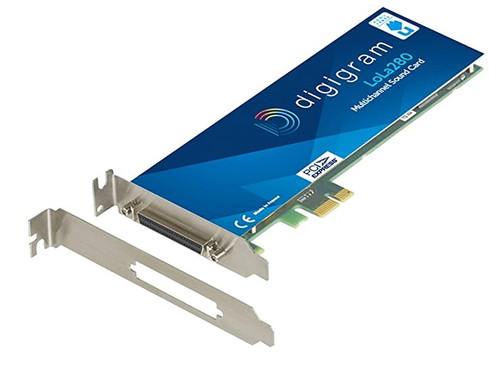Overview
Digigram VX882e Multichannel PCM Sound Card
The VX882e features eight input and output channels and offers balanced analog and AES/EBU connectivity, with the possibility to synchronize on an external clock (AES11, Word clock, black burst video). It can be used under Windows or Linux operating systems, with software applications based on standard driver interfaces such as WDM Kernel streaming, DirectSound, Wasapi, and ASIO for Windows, and Alsa for Linux.
- Developed for the broadcast industry
- Supports balanced analog and AES/EBU audio
- Interoperable with most third party software applications for audio production, under Windows and Linux
Features
- Multichannel linear PCM sound card
- PCI Express bus interface
- Eight balanced analog inputs and outputs, +24 dBu max level
- Four AES/EBU inputs/outputs, with hardware sample rate converter on each AES/EBU input
- Adjustable input and output analog and digital gains
- On-board 3-band parametric EQ and Maximizer effects
- Support for Linux (Alsa driver) and Windows 32-bit and 64-bit (WDM Kernel streaming, DirectSound, Wasapi, ASIO)
- Breakout cable or breakout box (BOB8) with XLR connectors for audio connectivity
Specifications
Configuration
- Bus/Format : PCI EXPRESS™ (PCIe®) x1, (x2, x4, x8, x16, x32 compatible)
- Size : 168 mm x 111 mm x 20 mm
- Power requirements (+3.3V / +12V) : 2.5A / 0.5A
- Operating: temp / humidity (non-condensing) : 0°C/+50°C • 5%/90%
- Storage: temp / humidity (non-condensing) : -5°C/+70°C • 0%/95%
Inputs
- Analog line inputs (mono) : 8 balanced*
- Maximum input level/ impedance : +24 dBu/ >10 kOhms
- Digital inputs (stereo) : 4 AES/EBU** with hw Sample Rate Converters, 7.5:1 to 1:8, up to 192 kHz
- Programmable input gain : analog: from –94.5dB à +15.5 dB (maximum sensitivity: 0 dBFs for –15.5 dBu input), digital:from –110 dB à +18 dB
- Other inputs : AES/EBU Sync (up to 192 kHz), Word clock (up to 96 kHz), LTC, Video
- AES11 synchronization : Yes
Outputs
- Analog line outputs (mono) : 8 servo-balanced***
- Maximum output level / impedance : +24 dBu / <100Ohms
- Digital outputs (stereo) : 4 AES/EBU**, up to 192 kHz
- Programmable output gain : analog: from –86 dB to +24 dB / digital: from –110 dB to +18 dB
- Other outputs : Word clock (up to 96 kHz)
Connectors
- Internal connectors : Inter-board Sync
- External connector : 68-pin SCSI MDR
- Digigram accessories available : Breakout cable or 2U 19″ Breakout Box
Audio specifications
- Sampling frequencies available : Programmable from 8 to 192 kHz
- A/D and D/A converter resolution : 24 bits
- Supported audio formats : PCM (8, 16, 24 bits), Float IEEE754
Audio Performance measured at Fs=48 kHz
- Frequency response (record + play) : 20 Hz–20 kHz: ±0.2 dB
- Channel phase difference: 20/20kHz : <0.2°/2°
- Dynamic range (A-weighted) : Analog In: >104 dB / Analog Out: >104 dB
- THD + noise 1 kHz at –1 dBfs : Analog In: <–97 dB / Analog Out: <–94 dB
- Crosstalk (Analog in or out) : 1 kHz at 24 dBu: <–100 dB / 15 kHz at 24 dBu: <–85 dB
* can be used with unbalanced signals
** can be used as S/PDIF interface as well
*** electronically servo-balanced outputs provide automatic level adjustment to accommodate either balanced or unbalanced lines











